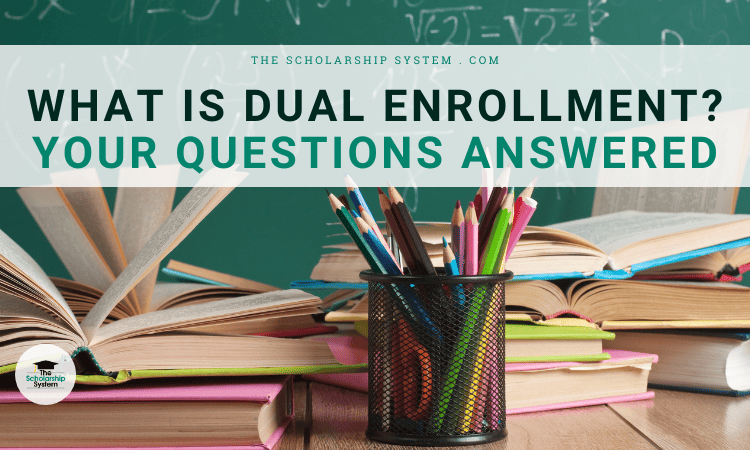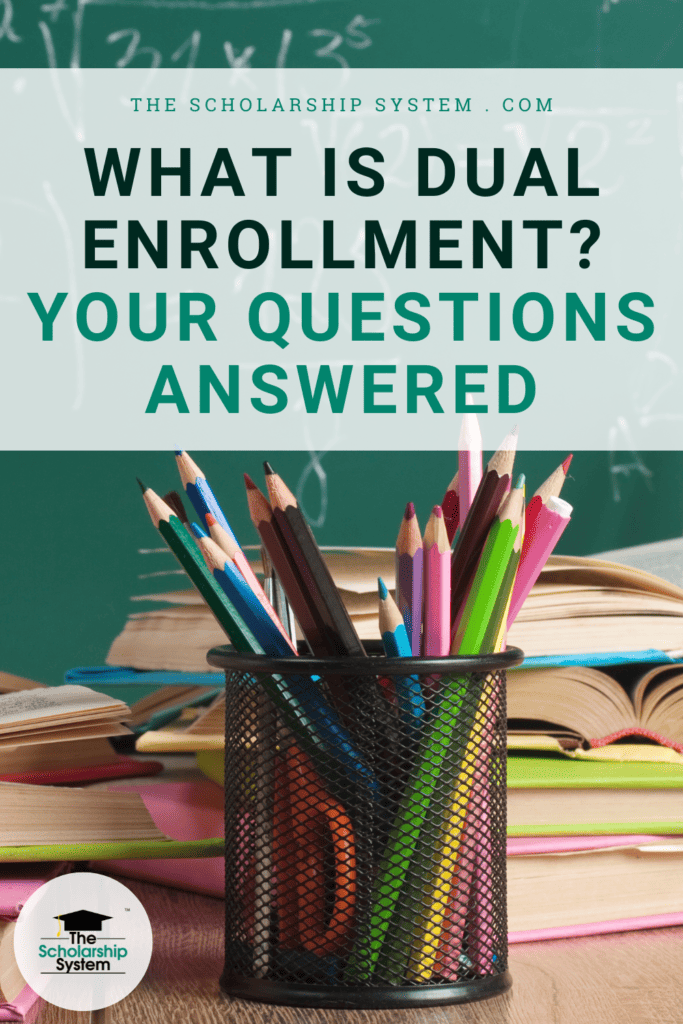Updated on April 28th, 2025
For high school students looking to get a jump start on their college journey, dual enrollment could be an attractive option. But what is dual enrollment, and is it something all high school students can access, given that it can be academically challenging?
While dual enrollment can significantly reduce students’ college costs, scholarships are also helpful to ensure college is affordable. If your student wants to reduce their out-of-pocket costs (and even graduate debt-free) by securing scholarships, sign up for our free college scholarship webinar! Take a quick trip over to http://thescholarshipsystem.com/freewebinar to reserve a spot today.
Overall, dual enrollment is a pretty straightforward concept, and it’s an option worth exploring for many high school students. Here’s a look at what dual enrollment is, how it works, and much more.
Contents
- 1 What Is Dual Enrollment in College?
- 2 How Does Dual Enrollment Work?
- 2.1 What Is Another Name for Dual Enrollment?
- 2.2 What Is the Difference Between AP And Dual Enrollment?
- 2.3 How Many Dual Enrollment Courses Can I Take?
- 2.4 Are Dual Credit Classes Harder Than AP?
- 2.5 How Much of a GPA Boost Is a Dual Enrollment Class?
- 2.6 What Grade Is Best for Dual Enrollment?
- 2.7 What Are the Disadvantages of Dual Enrollment?
- 2.8 What If My School Doesn’t Offer Dual Enrollment?
- 3 Types of Dual Enrollment Programs
- 4 Requirements for Dual Enrollment
- 5 Balancing Dual Enrollment with High School
- 6 How Does Dual Enrollment Help Students Save on College Costs?
What Is Dual Enrollment in College?
Dual enrollment is an educational option available to many high school students that allows them to enroll at two educational institutions at the same time, taking college level classes while still in high school. Typically, high school students are enrolled at a local high school and a college. With this arrangement, high school students are able to take college courses while they’re still in high school.
Is Dual Enrollment Free?
How much dual enrollment costs does vary. In some cases, the college courses are free to high school students who qualify for a formal dual enrollment program at their high school. In others, the cost of the classes is subsidized, making them less expensive but not completely free, and some may incur tuition fees. Finally, some types of dual enrollment aren’t subsidized at all, causing high school students who take the classes to owe the full amount.
Can Dual Enrollment Students Get Financial Aid?
Dual enrollment students typically aren’t eligible for traditional college financial aid that’s typically secured by completing the FAFSA. The FAFSA needs students to certify that they’ve earned a high school diploma or its equivalent, so high school juniors and seniors aren’t eligible.
The availability of these programs can vary significantly by school district, so students should check with their local school district for specific options.
However, there are various programs that help reduce or eliminate any college class-related expenses for high school students. These may be administered by states, specific participating colleges, or other similar entities.
How Does Dual Enrollment Work?
The college classes taken by dual-enrolled high school students functionally replace some of the courses they’d usually take as high schoolers, allowing them to engage in college level coursework early. As a result, they don’t necessarily have to take a heavier course load during their academic year to complete their high school graduation requirements. But the college courses also give them college credit, allowing them to get a jumpstart on their desired college degree.
It is critical to note that high school students can sometimes sign up for college courses on their own instead of through a formal dual enrollment program offered by their high school. With this strategy, they are also dual-enrolled but will have a heavier course load, as the college classes may not substitute for the courses they need to take to complete their high school graduation requirements.
Additionally, college classes that don’t align with a typical high school graduation requirement may not count toward their high school diploma. In those cases, it can also lead to a heavier course load depending on the number of high school courses required to graduate.
When it comes to where high school students take college-level courses, that can vary. In some cases, they’ll attend those classes at a nearby college campus or online. In others, they’re taught in a classroom at their high school.
What Is Another Name for Dual Enrollment?
While dual enrollment is the most widely used term, this type of academic arrangement also has another name. It’s sometimes referred to as “early college,” which is essentially a nod to the fact that it lets high school students start their college careers earlier than they usually could.
What Is the Difference Between AP And Dual Enrollment?
Both advanced placement (AP) and dual enrollment can help high school students earn college credit before they graduate from high school. However, how these arrangements work is very different.
AP courses are high school classes that offer an academic experience similar to a college class. However, they don’t guarantee college credit even if a student gets a passing grade. Instead, the student has to take an AP exam to prove competency. If they get a high enough score on the AP exam, then that typically results in college credit once they enroll at a university or community college.
Dual enrollment classes aren’t just academically similar to college courses; they’re actual college classes. As a result, earning a passing grade and completing the course will result in college credit at the college associated with the program.
Another difference is that while AP exam scores are widely accepted by colleges as a means of securing college credit in high school, that isn’t always the case with dual enrollment. Depending on how the program is designed and administered, college credit for those classes may be limited to specific universities or community colleges, so students should research any limitations before participating.
How Many Dual Enrollment Courses Can I Take?
Whether there’s a limit on how many dual enrollment courses a high school can take varies. Some states and schools have no formal limits in place, while others have caps. Students will need to check with a program administrator to see if there are restrictions in their area.
Are Dual Credit Classes Harder Than AP?
The difficulty of dual credit and AP classes typically exceeds what students would experience if they took an ordinary high school-level course, as both come with higher expectations. However, whether dual enrollment or AP classes are harder varies dramatically. Class difficulty can depend on numerous factors, including the subject, teacher or professor’s teaching style, and more. As a result, a dual enrollment class may be more difficult in some cases, while an AP course could be more challenging in others.
However, there is one area that can make earning college credit through an AP class harder: the AP exam. With dual enrollment, students need a passing grade in the class to secure college credit. With AP, a passing grade in the class isn’t enough to earn college credit. Instead, students need to get a passing score on the associated AP exam, and some students may find that challenging.
How Much of a GPA Boost Is a Dual Enrollment Class?
How much a dual enrollment class could boost a student’s GPA may vary. In some high school programs, a dual enrollment class is weighted with an extra 0.5 points. In that case, the highest scoring grade would work as a 4.5 when calculating a GPA instead of the traditional 4.0.
At times, a dual enrollment course might get weighted with an extra 1.0 point. When that happens, the highest grade in the class will earn a student a 5.0 to factor in when calculating their GPA.
Ideally, students should check with their program administrator to see how much a dual enrollment class is weighted before participating.
What Grade Is Best for Dual Enrollment?
In most cases, dual enrollment options are available to high school juniors and seniors. However, there can be other requirements beyond grade level, such as a minimum academic performance during their prior high school academic years.
What Are the Disadvantages of Dual Enrollment?
Dual enrollment means students are voluntarily taking courses that are more academically rigorous and involve college level work. As a result, passing the class could be more difficult, and students may experience more stress. In some cases, the tougher classes could make participating in extracurricular activities challenging, as they may require more time for studying or completing assignments than they would if they took traditional high school classes.
If dual enrollment classes aren’t available at their high school, students may have to commute to a college campus to participate, which could be difficult. If online options are available, that may not suit students who need more direct interaction.
Failing to complete a dual enrollment class with a passing grade can prevent a student from qualifying for their high school diploma. The course may also appear on their high school transcript, causing a low grade to make it harder for them to get into college.
What If My School Doesn’t Offer Dual Enrollment?
For students attending schools that don’t offer the same dual enrollment opportunities, AP classes are usually the best alternative. Some colleges and universities may also allow high school students to enroll on their own to take college classes, even if there isn’t a formal dual enrollment arrangement. However, that’s far less common, so AP courses are usually the simpler option.
Types of Dual Enrollment Programs
There are several types of dual enrollment programs available, including dual credit classes, concurrent enrollment classes, and early college programs. Dual credit classes allow students to earn both high school and college credit for a single course, while concurrent enrollment classes allow students to take college classes while still in high school. Early college programs, on the other hand, allow students to earn an associate’s degree or certificate while still in high school. These programs can be offered through community colleges, local colleges, or online institutions, providing high school students with a range of options to suit their academic goals and career aspirations. Each type of program offers unique benefits, so students should explore all available options to find the best fit for their needs.
Requirements for Dual Enrollment
To participate in a dual enrollment program, high school students typically need to meet certain requirements, such as maintaining a minimum GPA, passing placement tests, or completing prerequisite courses. Students may also need to submit an application, transcripts, and letters of recommendation to be considered for dual enrollment. Additionally, students should check with their school counselor to determine the specific requirements for their school’s dual enrollment program and to ensure they are eligible to participate. It’s also important for students to understand the dual enrollment meaning and policies at their school and the college they plan to attend. By meeting these requirements, students can take advantage of the opportunities dual enrollment offers.
Balancing Dual Enrollment with High School
Balancing dual enrollment with high school can be challenging, but with proper time management and self-discipline, students can succeed. High school students should prioritize their coursework, creating a schedule that allows them to manage their time effectively and meet deadlines. They should also communicate regularly with their school counselor and college instructors to ensure they are meeting the requirements for both their high school and dual enrollment courses. By staying organized, focused, and committed, students can reap the benefits of dual enrollment, including significant savings on college costs, enhanced critical thinking skills, and a head start on their college education. With careful planning and dedication, high school students can successfully navigate the demands of dual enrollment and set themselves up for long-term academic and professional success.
How Does Dual Enrollment Help Students Save on College Costs?
Dual enrollment can help students reduce their college costs because many of the programs either make college classes available to high schoolers for free or at a significantly reduced rate. Since that’s the case, students will earn college credit without having to spend the same amount of money as they would if they were attending as a college student.
Through dual enrollment classes, students may also shorten the amount of time they’ll physically attend a college. That can lead to less spent on room, board, fees, and other expenses, too, leading to a significant savings.
While dual enrollment can significantly reduce students’ college costs, scholarships are also helpful to ensure college is affordable. If your student wants to reduce their out-of-pocket costs (and even graduate debt-free) by securing scholarships, sign up for our free college scholarship webinar! Take a quick trip over to http://thescholarshipsystem.com/freewebinar to reserve a spot today.









Leave a Reply